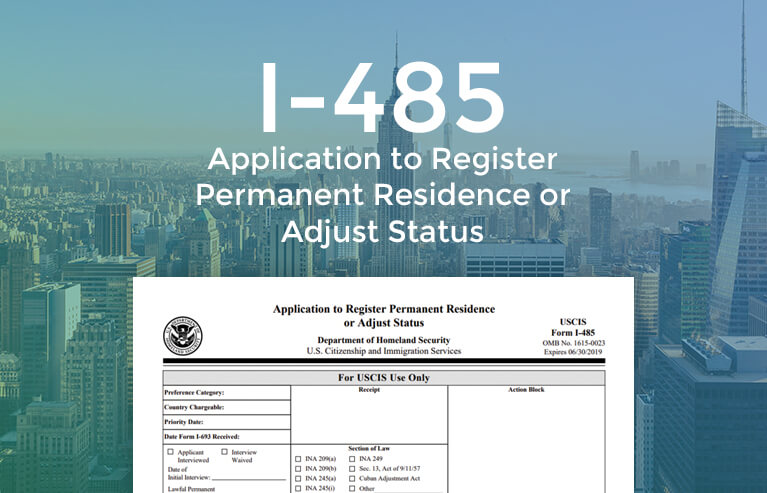
Needless to say, submission of documents for earning a green card is a matter of great concern, and many applicants would like to know what to expect next and how long they need to wait for the approval. While there are some general steps and procedures, several specific aspects influence the timeframe of processing:
- USCIS workload at the time the documents are submitted;
- basis of eligibility for the card;
- compliance with USCIS requirements;
Depending on these factors, the timeline can vary, but the basic scheme is as follows.
RECEIVING A NOTICE OF ACTION
2-3 weeks on the date of filing
Upon the documents submission, applicants get feedback from U.S. Citizenship and Immigration Services, confirming that the papers are delivered and the processing begins. The applicants receive Form I-797C, and usually it takes a couple of weeks for the agency to issue it. Given that the papers are prepared correctly, the notice will confirm the applicant’s status, and from this date clock starts ticking.
But when the applicant failed to prepare the papers in line with USCIS instructions, the letter is likely to inform about the agency refusing this application. As an alternative, USCIS can mail a Request for Evidence, asking for some evidence to be sent in addition. Obviously, both options lengthen out the procedure, and therefore it’s vital to fully meet the criteria for the paper submission.
Note: Take some trouble to save the message from USCIS, since it has a receipt number, granting access to case status monitoring through USCIS website. If the Form I-797C is not mailed to your address, submit an inquiry via the corresponding section of the official website.
Based on statistics available for AOS applications, about 9 per cent of them are rejected, while improper filing of the documents often results in delayed approval or even leads to serious troubles with applicant’s current status. Therefore, we offer a step-by-step guide for submitting the papers, helping eliminate mistakes and delays. When following our tips, you are guaranteed to have the application accepted by U.S. Citizenship and Immigration Services.
RECEIVING A NOTIFICATION ON BIOMETRICS APPOINTMENT
3-5 weeks on the date of filing
The notice of action is followed by a notification, informing an applicant about where and when his/her biometrics appointment will take place. Routinely, it is conducted in the closest Application Support Center - here, the applicant’s fingerprints are taken for further background investigation. This requirement applies to all the people seeking for their permanent residence, so you shouldn’t worry about this common procedure.
Note: It is permitted to re-schedule the appointment, provided that an applicant have a conceivable reason to ask for reassigning, but in general, it’s better to stick to the schedule assigned. You can find out more on this in our biometrics appointment section.
UNDERGOING THE BIOMETRICS SCREENING
5-8 weeks on the date of filing
Biometrics screening (or appointment) takes about half an hour – the applicants are photographed and fingerprinted, and also the examples of their signatures are taken. Make certain to read the list of items required for the screening, which is included into the biometrics notification. For entering a USCIS site, a government-issued ID with a photo is required, namely a military ID, DL or state-issued identification card, as well as a national passport or ID.
Note: Since biometrics are collected for checking applicant’s criminal history among other things, think of consulting an immigration attorney, if there is any chance you do have criminal records (even like driving under the influence). The lawyer can conduct the background investigation in advance to address the issue properly. Otherwise you might not be entitled to obtain the required status.
RECEIVING AN EMPLOYMENT AUTHORIZATION DOCUMENT
12-16 weeks on the date of filing
In case an applicant also applied for Employment Authorization and Travel Documents (Form I-765 and I-131 correspondingly), appropriately prepared I-485 documents will give him or her access to an EAD card, widely called a work permit. The card serves as both documents, permitting to work in the USA and to cross the country border based on advance parole terms.
Note: It will be smart to make a copy of the card (both sides) for further use.
RECEIVING AN INTERVIEW NOTIFICATION
16-40 weeks on the date of filing
Normally, the next stage in the process of earning a permanent resident status is getting another notice of action – this time, informing about an interview. Sometimes, both applicant and petitioner are required to have the interview, but this is optional and you can be asked to come alone as well. Also, there is a chance USCIS will waive the interview – mainly, this depends on applicant’s ability to collect all required documents for smooth Adjustment of Status process.
Anyway, one shouldn’t feel nervous about the interview, since the appointment doesn’t imply that something is wrong with the case. It rarely lasts more than half an hour and usually takes place at the closest USCIS office.
Note: If you happened to relocate after filing the AOS form, inform the agency about your new address within ten days following the move. File Form AR-11 and contact the agency at 1-800-375-5283 to comply with USCIS requirements.
HAVING THE INTERVIEW
24-48 weeks on the date of filing
If you are scheduled for the interview, it is worthwhile making some preparations, including reviewing all the forms submmitted within the AOS process to fill the gaps in your memory and to be ready to answer related questions. Also, make certain to collect the documents required for the interview:
- all the original papers copied for submission to U.S. Citizenship and Immigration Services
- passport with a visa
- complete copies of immigrant petition and AOS application
- EAD/Advance parole, if available.
Note: There might be other documents required for the interview, so make a point of checking the USCIS notification for a comprehensive list.
RECEIVING PERMANENT RESIDENT STATUS
32-56 weeks on the date of filing
Sometimes, applicants obtain their permanent resident cards right within the interview. However, the card can be sent by mail, provided that the application is approved. If it isn’t approved, the applicant will get a letter from the agency with explanations as to the denial.
Upon receiving a green card, a permanent resident is free to conduct his/her labor activity in the United States and to travel abroad, using the card to confirm their rights instead of carrying the EAD, which is no longer required. Bear in mind that upon the status approval, you can get your passport stamped with an I-551 stamp, verifying your lawful status and enabling you to re-entry the country.
Note: In case the card isn’t delivered by mail, don’t hesitate to make an inquiry via the USCIS official uscis.gov.
Generally, the entire procedure lasts 8-14 months on the date of submission, while the final timeframes vary according to the basis for the application (i.e. whether an applicant is an employee, refugee, etc.). Depending on specific scenarios, additional papers or an extra interview might be required, and this predetermines pretty much whether the process is rather fast or slow footed. Either way, take advantage of online tools offered via USCIS website, such as monitoring case status or checking processing times. If there is a delay with the case processing, feel free to make an inquiry.

